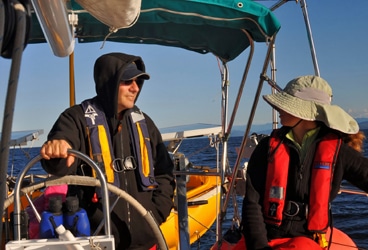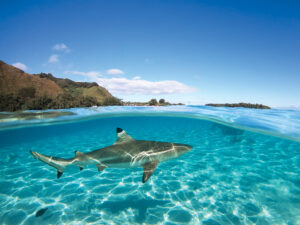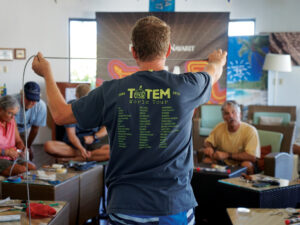
In the spring of 2010, I emailed John and Cindy of Port Ludlow, WA. I’d learned online that they owned Namaste, one of the dozen-or-so Fuji 40s ever built. I told them Windy and I were considering buying a sister ship for sale in Mexico. I had a million questions.
Cindy got right back to me and in several emails she gave me lots of valuable information about the boat. A month later, we did buy that 1978 Fuji 40 in Mexico, named her Del Viento, and eventually sailed away. And we’ve kept in touch with John and Cindy. They’ve hosted us at their home several times and we’ve become friends.
Like many Puget Sound-area boaters, John and Cindy haven’t yet had the time, opportunity, or need to sail outside the 6,900-square-mile watery playground that is the Salish Sea. And though navigating their “protected” home waters is often more demanding from a seamanship perspective than offshore or coastal cruising, the North Pacific Ocean that lies just beyond Cape Flattery remained for them an unknown.
No longer. A few weeks ago, John sailed with us from Port Angeles, WA to Astoria, OR. Afterward, I asked him to write about his experience so that I could post it here. Take it John:
“Several months ago I emailed my friends Michael and Windy and asked if I could accompany them part of the way down the coast in the fall on their return trip from Alaska back to Mexico. At the time it was early summer and it sounded like a good idea. Now here I am on a late September night; it’s dark, cold and raining and I need to climb down a wet, vertical, 30-foot ladder to board their dinghy from the pier.
“I am not thrilled with heights and I was definitely experiencing some pre-trip jitters as I followed 7-year-old Frances down, in my foulies, one rung at a time, trying to maintain some bravado. I survived and we were all soon aboard_ Del Viento_, settling in and catching up on the events in each other’s lives.
“We turned in for the night as we were to set out early the next day. The plan was to leave from Port Angles, round Cape Flattery and cross the Columbia River bar into Astoria. (Ocean sailing with a bar crossing-what more could I ask for?) Unfortunately, sleep did not come easily. My mind instead vividly reenacted many well-known tragedies at sea, leaving me to wonder whether I would see my family again. (I know, very melodramatic.)
“Windy woke me at 0630. It was cloudy, but no longer raining, there was little wind. We weighed anchor without trouble and headed into the Strait of Juan de Fuca. Michael and the girls were still asleep and Windy and I got the chance to talk about their routines when planning a passage. I was excited to be doing a coastal ocean passage on the sister-ship to our Namaste.
“Now underway, my anxiety started to dissipate and even the clouds opened up to a bright, sunny day. We motored all day towards Cape Flattery, keeping a sharp eye out for the occasional log. At sunset we were abeam Neah Bay and I could see the light off Cape Flattery, where we’d make the big ‘left turn.’ At this point, I could feel the increasing size of the ocean swell. Too, there seemed to be more logs here at the entrance to the Strait. It was getting dark fast and to my inexperienced self, these did not seem to be ideal circumstances. But we continued on and I watched the desolate Washington coast disappear behind us.
“We decided I would take the 0100 to 0400 watch, so I soon headed to my berth to try and sleep before my turn. Before I knew it, Michael woke me and in the cockpit he briefed me on conditions before leaving me to settle into my watch. Although I was nervous, three hours passed without incident. Windy showed up around 0400 to relieve me and I found sleep came easier than before.
“I had the early shift the next night and by this time the nervousness I felt the night before was gone. The hardest part about that watch was being cold, especially the last hour that seemed to drag. But Michael reminded me about how pleasant a night watch can be in the tropics, wearing only shorts and a T-shirt.
“Early on the third morning, Windy woke me to let me know we were getting ready to cross over the Columbia River Bar. We had arrived a few hours earlier than planned and so we would be crossing in the dark. While the conditions seemed calm, we still contacted the Coast Guard to get the latest conditions. The most unsettling part about crossing the bar was the number of lights. Even though we all know “red right returning,” there seemed to be a lot of red lights and it was a bit confusing. But this is where the iPad came in handy, as we were able to follow the channel in, even with fishing boats and the occasional supertanker close by. By sunrise we had tied up to the dock in Astoria and my first trip down the coast was over.
“In the days and weeks that have followed, I have thought about the trip down the coast many times. While I did not cross any oceans or make landfall on a distant shore, I returned home with a sense of accomplishment and a better understanding of what to expect when we point Namaste‘s bow south. For me, dealing with the unknowns and the what-ifs have been a hard part of preparing for our own trip. It is always possible to imagine the worst-case scenario. And while I often talk to sailors who can tell you about this or that terrible storm they were in, after spending time with Michael and Windy, I realize that with careful planning, keeping an eye on the weather, and a little luck, most of the drama can be avoided. I feel the greatest thing I came away with was a feeling that although I know our own cruise will not always be easy, I now have a greater sense of confidence in being able to make our own dreams come true.”
–MR
In our twenties, we traded our boat for a house and our freedom for careers. In our thirties, we slumbered through the American dream. In our forties, we woke and traded our house for a boat and our careers for freedom. And here we are. Follow along at http://www.logofdelviento.blogspot.com/








